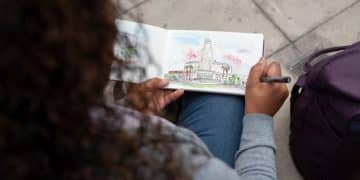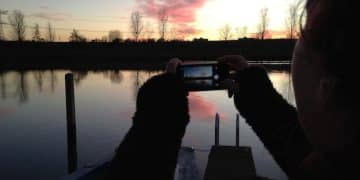Travel Journaling for Mindfulness: Enhance Well-Being & Experiences
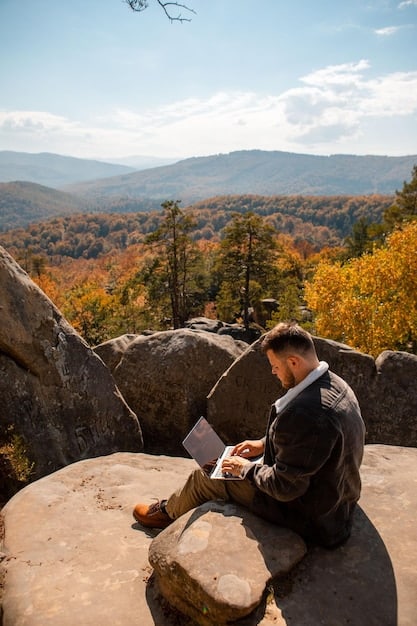
Engaging in travel journaling for mindfulness offers a profound avenue to document experiences, deepen self-awareness, and significantly enhance overall well-being, transforming transient moments into lasting personal growth.
In a world increasingly characterized by rapid change and digital distraction, the deliberate act of travel journaling for mindfulness: document your experiences and enhance your well-being emerges as a powerful antidote. This practice extends far beyond mere trip logs, evolving into a contemplative tool that fosters presence, gratitude, and a deeper connection with both your travels and your inner self.
The Essence of Mindful Travel Journaling
Mindful travel journaling is an intentional practice that encourages you to slow down, observe, and reflect on your travel experiences. It’s not about cataloging every single detail, but rather about capturing emotions, insights, and sensory perceptions that might otherwise fade into the background. This practice transforms ordinary trips into extraordinary journeys of self-discovery and personal growth.
The core principle lies in engaging all your senses and emotions. Instead of passively observing, you actively participate in your surroundings, translating those experiences into written form. This engagement cultivates a heightened state of awareness, making each moment more vivid and memorable. It’s a departure from the quick snapshot, moving towards a more enduring and reflective capture of reality.
Beyond the Sights: Tapping into Sensory Details
True mindful journaling transcends visual descriptions. It invites you to record the sounds, smells, tastes, and textures that define your travel moments. This multi-sensory approach enriches your memories and allows for a more holistic recall of your journey upon reflection.
- Soundscapes: Describe the jingle of a streetcar, the murmur of a foreign language, the rustle of leaves in an ancient forest.
- Aromas: Recount the scent of fresh bread from a Parisian boulangerie, the salty air of the coastline, or the exotic spices from a Moroccan market.
- Tastes: Detail the nuances of a local dish, the bitterness of a strong coffee, or the sweetness of freshly picked fruit.
- Textures: Note the rough feel of an ancient stone wall, the softness of a silk scarf, or the gritty sand between your toes.
By consciously seeking out these sensory details, your brain creates stronger neural pathways, embedding the memories more deeply. This process naturally enhances mindfulness, as it pulls you into the present moment, away from distractions and worries about the past or future.
The act of writing itself becomes a meditative process. The physical motion of pen on paper, or even the deliberate typing, can be grounding. It creates a space for mental decluttering, allowing thoughts and observations to flow freely without judgment. This unstructured flow is crucial for genuine introspection and for uncovering subconscious reactions to new environments. Ultimately, the quality of your journaling is measured not by quantity but by the depth of personal engagement.
The Psychological Benefits of Documenting Journeys
The act of documenting your travel experiences through journaling offers a myriad of psychological benefits that extend far beyond simply remembering your trip. It serves as a powerful tool for emotional regulation, stress reduction, and cognitive processing, fundamentally enhancing your mental well-being.
Engaging with your memories in a structured, reflective way allows for a deeper integration of experiences into your personal narrative. This is particularly valuable in travel, where new stimuli can often be overwhelming. Journaling provides a mechanism to unpack these experiences, giving them context and meaning.
Emotional Processing and Stress Reduction
Travel, while often exhilarating, can also be stressful. Navigating unfamiliar environments, dealing with unexpected challenges, and stepping outside your comfort zone can trigger a range of emotions. Journaling provides a safe outlet for processing these feelings, whether positive or negative.
- Ventilation: Writing about frustrations, anxieties, or discomforts can help release pent-up emotions, preventing them from festering.
- Perspective: Articulating challenges on paper often helps in gaining a clearer perspective, making problems seem less daunting.
- Gratitude Cultivation: Consciously noting moments of joy, gratitude, or awe can amplify positive emotions and shift your overall outlook.
This process of emotional processing isn’t just about reducing negative feelings; it’s also about reinforcing positive ones. By actively acknowledging moments of immense joy or profound connection, you train your brain to seek out and appreciate these experiences more regularly, even when you’re not traveling. This leads to a more optimistic and resilient mindset in daily life.
Moreover, the discipline of regular journaling helps in developing metacognitive skills—the ability to think about your thinking. You become more attuned to your internal states, understanding what triggers certain reactions and how to respond more effectively in the future. This self-awareness is a cornerstone of emotional intelligence and resilience, providing long-term benefits well beyond the duration of your trip. The pages of your travel journal become a mirror reflecting your inner landscape, charting your growth and transformations.
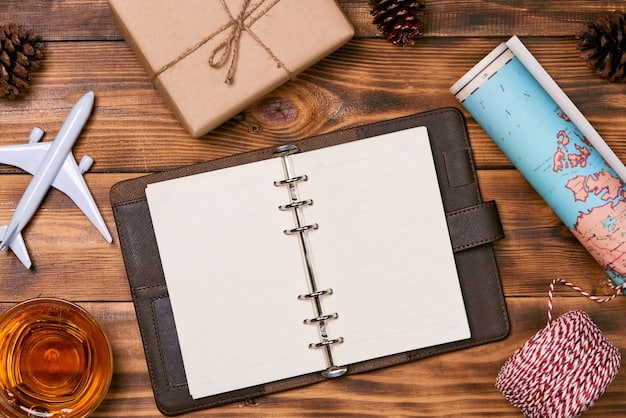
Practical Approaches to Starting Your Travel Journal
Embarking on a travel journaling practice doesn’t require a specific skill set or expensive materials. The most crucial element is a willingness to engage thoughtfully with your experiences. Starting is often the hardest part, but with a few practical approaches, you can ease into a habit that enriches your travels.
Before you even leave, consider what kind of journal suits your style. A small, portable notebook might be ideal for quick notes on the go, while a larger, more structured journal could be better for longer reflections at the end of each day. There’s no single right answer; choose what feels most comfortable and accessible to you, ensuring it integrates seamlessly into your travel routine rather than becoming a burdensome task.
Choosing Your Tools and Setting the Scene
The tools you use can influence your journaling style. While a simple pen and paper are perfectly adequate, some find inspiration in specific journals or art supplies. Environment also plays a key role; finding a quiet, comfortable spot can dramatically enhance your journaling session.
- Journal Selection: Options range from simple bound notebooks to specialized travel journals with prompts or maps. Consider durability and size for travel.
- Writing Instruments: A reliable pen is essential. Some prefer fountain pens for a more deliberate feel, while others opt for easy-to-carry ballpoints.
- Creative Additions: Don’t limit yourself to words. Consider adding small sketches, watercolor paints, pressed flowers, or sticky notes with unique ephemera.
- Finding Your Space: Whether it’s a cozy cafe, a park bench, or your hotel room, choose a setting where you feel relaxed and undistracted.
Once you have your tools, establish a routine. This doesn’t mean rigid scheduling, but rather integrating journaling naturally into your day. Perhaps it’s during breakfast while planning the day, or as a reflective ritual before bed. Consistency, however loose, helps build the habit. The quality of your entries will deepen as you become more comfortable with the process, moving from descriptive facts to more profound observations and feelings. This evolution makes the practice more rewarding over time, turning a simple log into a deeply personal keepsake.
Remember, the goal is not perfection, but participation. Your journal is for you, a private space for exploration and reflection. Don’t worry about grammar, spelling, or penmanship. Focus on capturing the raw essence of your experiences and emotions. This freedom from judgment allows for greater authenticity and deeper personal insights, truly making it a tool for mindfulness and well-being.
Integrating Mindfulness Techniques into Journaling
While journaling itself is a mindful activity, intentionally integrating specific mindfulness techniques can deepen its impact, allowing for richer observations and a more profound connection to your travel experiences. These techniques transform passive reflection into active engagement with the present moment.
Mindfulness is often defined as paying attention to the present moment, on purpose, and non-judgmentally. When applied to journaling, this means consciously directing your focus without getting caught up in internal narratives or self-criticism. It’s about witnessing your experience as it unfolds and then documenting that unfiltered perception.
Prompting Presence and Sensory Awareness
Structured prompts can guide your attention to specific aspects of your experience, encouraging a more nuanced and mindful observation. These prompts act as anchors, pulling your awareness into the here and now, preventing your mind from wandering.
- The “Five Senses” Exercise: Before writing, take a moment to list five things you can see, four things you can hear, three things you can feel, two things you can smell, and one thing you can taste. Then, write about one of these observations in detail.
- “What Am I Experiencing Right Now?”: Start your entry by asking this question. Describe your immediate physical sensations, emotional state, and surrounding environment without labeling or judging.
- “Observation Walk” Reflection: After a walk or excursion, write about a specific detail you noticed that you might normally overlook—a crack in the pavement, a uniquely patterned leaf, an interesting interaction.
Beyond structured prompts, consider dedicating short periods solely to observation before you even pick up your pen. Sit in silence for a few minutes, simply taking in the ambient sounds, the feeling of the air on your skin, or the visual details of your surroundings. This pre-writing meditation prepares your mind, making it more receptive to thoughtful reflection when you do begin to write. The more you practice this pre-journaling awareness, the more naturally the mindful observations will flow onto the page.
Another powerful technique involves focusing on the breath while journaling. Take a few deep breaths before you start writing, and occasionally return to your breath during pauses. This helps to anchor you in the present, preventing your mind from racing ahead or dwelling on past events. It transforms journaling from a task into a calming, centering ritual, amplifying its benefits for well-being. This intentional practice helps cultivate a deeper sense of internal peace, making writing a truly restorative act.
Overcoming Obstacles and Maintaining Consistency
Like any new habit, maintaining a travel journaling practice can present challenges. Life on the road is unpredictable, and it’s easy to fall out of routine. However, recognizing common obstacles and developing strategies to overcome them is key to turning journaling into a sustainable and rewarding practice.
One of the biggest hurdles is the perception of needing ample time or profound insights. Many aspiring journalers stop before they even start, intimidated by the idea of lengthy, eloquent entries. The reality is that even a few minutes dedicated to jotting down thoughts or observations can be incredibly beneficial. Consistency trumps quantity when it comes to mindfulness and well-being.
Common Challenges and Practical Solutions
From a busy itinerary to creative blocks, various factors can disrupt your journaling flow. Addressing these proactively can help you stay on track and reap the full benefits of the practice.
- Lack of Time: Don’t aim for long sessions. Even 5-10 minutes each day or every other day can make a significant difference. Schedule it like any other important activity.
- “Nothing to Write About”: Shift your focus from grand events to small observations. What did you eat? What sound caught your attention? How did a particular interaction make you feel?
- Perfectionism: Your journal is for you. Ignore grammar, spelling, or neatness. The goal is expression and reflection, not literary masterpiece.
- Forgetting Materials: Keep your journal and pen in an easily accessible bag or pocket. Make it a habit to check for them before heading out.
- Privacy Concerns: If you’re traveling with others, find dedicated quiet time, or consider a digital journal that can be password-protected.
Embrace flexibility. Some days you might write pages, other days just a few words. The beauty of travel journaling lies in its adaptability. Don’t let occasional lapses define your practice; simply pick up where you left off. The act of returning to the journal, even after a break, is a testament to your commitment to self-reflection and well-being. Each entry, no matter its length or depth, contributes to a holistic record of your journey, both external and internal. This ongoing commitment reinforces the mindful benefits over the long term.
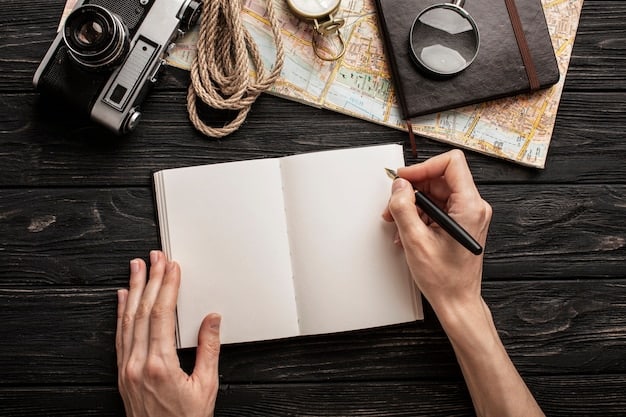
Beyond the Trip: Re-engaging with Your Travel Journal
The journey doesn’t end when you return home and unpack your bags. In fact, a significant part of the mindful benefits of travel journaling comes from re-engaging with your entries long after the trip is over. This act of revisiting your journal transforms it from a mere record into a powerful tool for ongoing self-reflection, learning, and gratitude.
Your finished journal is more than just a collection of memories; it’s a living document of your personal growth and the evolution of your perspectives. Taking the time to reread your entries allows you to gain new insights, appreciate how far you’ve come, and relive experiences with a fresh perspective that time and distance often provide.
Reliving Memories and Gaining New Insights
Revisiting your journal can bring rediscovered joy, but also new understandings. Time offers distance, allowing for a more objective view of past events and reactions. This can be particularly enlightening for moments that were challenging during the trip.
- Emotional Check-in: Observe how your feelings about certain experiences may have changed. Did a once-stressful moment now seem like a comical anecdote?
- Pattern Recognition: Identify recurring themes, preferences, or challenges in your travels. This can inform future travel plans and personal development.
- Gratitude Amplifier: Be reminded of the beauty, kindness, and wonder you encountered, reinforcing a sense of appreciation for life’s experiences.
- Learning and Growth: See how you handled unexpected situations or adapted to new cultures. This can highlight your resilience and capacity for growth.
Consider setting aside dedicated time, perhaps monthly or annually, to spend with your journal. Treat it as a cherished book, perhaps with a cup of tea in a quiet corner. This deliberate act of re-engagement reinforces the mindful practice, extending its benefits beyond the immediate act of writing. You might even find new connections between different entries, or see how seemingly unrelated experiences contributed to a larger personal narrative. This continuous interaction turns your journal into a valuable resource for self-understanding, a testament to your personal journey, and a spring of inspiration for future adventures.
The insights gained from re-reading your journal can be invaluable for personal growth. They can inform decisions about future travel, career paths, or even personal relationships. It’s a tangible record of your life experience, filtered through your unique perspective, offering endless opportunities for introspection and renewed appreciation for the world and your place within it. This enduring connection strengthens your well-being, long after the last page has been filled.
| Key Aspect | Brief Benefit |
|---|---|
| ✍️ Deeper Engagement | fosters profound connection to travel moments through observation. |
| 🧠 Enhanced Well-being | Offers psychological benefits like emotional processing and stress reduction. |
| 🎯 Mindful Practice | Integrates specific techniques like sensory awareness for deeper reflection. |
| 🔄 Continuous Growth | Revisiting entries provides ongoing insights and strengthens personal narrative. |
Frequently Asked Questions
▼
Mindful travel journaling is an intentional practice of documenting travel experiences with heightened awareness, focusing on sensory details, emotions, and personal insights rather than just facts. It aims to deepen your connection to the present moment, cultivate gratitude, and enhance overall well-being by transforming trips into journeys of self-discovery.
▼
Journaling offers psychological benefits during travel by providing an outlet for emotional processing, reducing stress, and fostering gratitude. It allows you to vent frustrations, gain perspective on challenges, and amplify positive experiences, contributing to greater emotional regulation and mental resilience in unfamiliar environments.
▼
To start a travel journal, you primarily need a journal or notebook and a reliable writing instrument like a pen. While optional, creative additions such as small sketches, watercolor paints, or collected ephemera like tickets and pressed flowers can enrich your entries. The most important tool is your willingness to observe and reflect.
▼
Integrate mindfulness by using prompts like the “Five Senses” exercise to focus on sensory details, or “What Am I Experiencing Right Now?” to observe immediate sensations without judgment. Dedicate brief moments to silent observation before writing, and use breath awareness to stay grounded. These techniques enhance presence and deepen reflective capacity.
▼
The long-term benefits of travel journaling include deeper self-understanding, continuous personal growth, and a profound sense of gratitude. By revisiting your journal, you can relive memories, identify patterns in your experiences, and gain new insights into your reactions and adaptations, turning past trips into ongoing sources of inspiration and learning.
Conclusion
Travel journaling for mindfulness offers a rich, multi-faceted approach to experiencing the world, transforming transient moments into enduring lessons and cherished memories. It is a powerful practice that goes beyond simply recording events, fostering deep introspection, emotional processing, and a continuous cultivation of well-being. By embracing this art of reflective documentation, travelers not only enhance their journeys but also enrich their inner lives long after the adventure has concluded.


